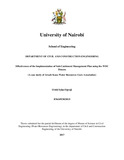| dc.description.abstract | Water resources are of paramount importance in deriving the development of each and every country and support all the sectors of the economy. Various forums have emphasized the need to conserve and protect the water resources for the future generation. These includes the United Nations Conference on water held in 1977 in Mar del Plata, Argentina, International conference of Water and Environment held in Dublin, Ireland in 1992, the United Nations Conference on Environment and Development among others.
In Kenya, water sector reforms resulted in the adoption of the 2002 Water Act in Kenya, which established the Water Resource Management Authority (WRMA), that is vested with the responsibility of management of water resources in the Country. To support WRMA in the management of Water Resources within the Catchment region, there was a need to establish Water Resource Users Associations (WRUAs). The operations of these Associations are to be governed by the Sub-Catchment Management Plan (SCMP) developed with reference to the Water Resources Users Association Development Cycle as established by WRMA and Water Services Trust Fund (WSTF).
This study aimed at assessing the implementation of the SCMP using the WDC process in the management of Water Resources by Awach Kano WRUA. The study was conducted at four levels by administering one focus group discussion and WRUA Capacity Assessment tool with the management committee of Awach Kano WRUA, administering 98 semi-structured questionnaires to the members of Awach Kano WRUA and conducting two Key Informant Interviews with the WRMA sub regional office in Kisumu and the Water Services Trust Fund. Water quality analysis tests and desk reviews were also conducted.
The fooling tools were used for measuring the performance of the WRUA
1. WRUA Capacity Assessment tool
2. WDC toolkit
3. Global Water Partnership toolbox
According to the WRMA Sub Regional Office, the implementation of the SCMP was effective and rated it at 85% while the WRUA management committee rated it at 90%. According to the members of Awach Kano WRUA who were interviewed, 83% knew about the existence of the
vi
Awach Kano Sub Catchment Management Plan while the rest (17%) did not know of its existence. For those who knew of its existence, 86% were involved in its development while 14% were not involved. For those who were involved, they were either involved in drafting and validating (48%), only drafting (12%) or only validating (40%) the SCMP.
Water pollution, deforestation and water abstraction are challenges faced in water resource management and the WRUA were seen as taking the following steps by the respondents to avert this: planting trees 30%, building gabions 30%, desiltation of pans 15%, mapping polluters 10%, water quality survey 8%, and mapping of water abstractors 7%. Actions taken against the water polluters were reported to local administrators (55%), creation of awareness on the importance of not polluting the water sources (29%) and restricting bathing along the river banks (14%).
Since the beginning of the operations of the WRUA, 100% of the respondents felt that there has been a change in the management of water resources. Averagely, 86% of the WRUAs felt that the actions taken by Awach Kano WRUA were effective in the management of Water Resources in the area. According to the members, the implementation of the SCMP was effective since it had resulted to: reduction in deforestation, reduction in water pollution/ improvement in water quality, reduction in gully erosion, reduction in illegal water abstraction and disiltation of pans.
The WRUA capacity assessment tool indicated that the WRUA is headed towards maturity, however there are some gaps the WRUA needed to work on to attain maturity.
Water Services Trust Fund indicated that Awach Kano WRUA had used the funds provided to them effectively and this made them qualify for the 3rd level funding. Some of the challenges faced by the WRUA were:
Low allocation of funds to the WRUA by the WSTF.
Low technical skills in the implementation.
Slow understanding of the WDC concept by the WRUA members as the WRUA members had not appreciated the concept of Water Resources Management as opposed to Water Service Provision.
Delayed funding from WSTF as the WRUA could not continue with their activities since they lacked financial resources.
vii
In conclusion, the WRUA members were not adequately involved in the development and rolling out of the SCMP since not all participated in the whole process. The WRMA sub regional office had been actively involved in the development and rolling of the SCMP. A Support Organization helped in the development of the SCMP. The WRUA planted trees, sensitized the communities on forestation and prohibited charcoal burning in the sub catchment. Other activities undertaken by the WRUA included construction of gabions, planting sisal, planting cactus and protecting riparian lands. Therefore, the WRUA effectively implemented the SCMP though the activities were achieved at a small scale. The activities undertaken were also effective since they helped reduce further erosion of the Awach Kano River and restoration of ecosystems by constructing gabions, planting trees and preventing more pollution. However, more funds are needed for the WRUA to realise a bigger impact.
The study recommends that WRMA should advocate for more funding resources on behalf of WRUAs in ensuring that the WRUAs have annual allocation from the National and County Governments to avoid dependency on donor funding. The WRUAs need to partner with other development agencies to support their operations. The WRUA should have an office and skilled staff to support in the implementation of activities to ensure more efficient and effective delivery of services. WRMA together with WSTF should revise the WDC to ensure that it addresses the issues of sustainability of the WRUA especially on ensuring that the WRUA receives other sources of funding. The revised WDC should also address the issues of technical capacity of the WRUA. | en_US |



